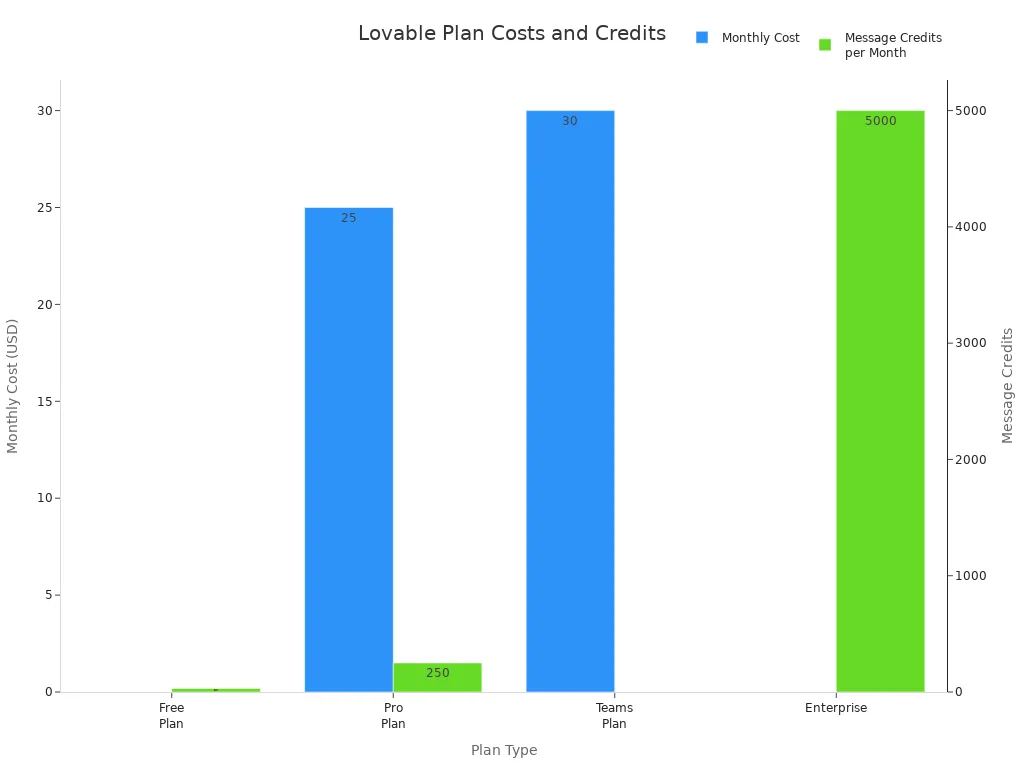Why Building with Lovable Isn’t as Easy as It Looks for Non-Tech Users

You might have heard that building with lovable is a breeze, even if you don’t have a tech background. Many people believe this platform is totally no-code and simple for anyone. The truth feels different once you start. You quickly notice lovable asks for more than just dragging and dropping. You need to think about backend steps and sometimes even custom code. If you feel stuck or frustrated, you’re not alone. Every new tool takes some learning, and that’s okay.
Key Takeaways
Building with Lovable is easier than coding the old way. But you still need to learn and be patient. Non-technical users have to pick up new skills. You need to know how to ask AI clear questions. You also need to think in an organized way. Basic product management is important too. Start with small steps by using templates. Try simple features first to build your app slowly. Use Lovable’s community for help when you get stuck. Read guides and use AI help to fix problems. This will make your project better. Make goals that you can really reach. Test your ideas early to see if they work. Keep practicing so you can make great apps.
Lovable’s Simple Image
Marketing vs. Reality
When you first hear about lovable, you might think it will solve all your problems. The marketing paints a bright picture. You see words like "fast," "easy," and "no coding needed." The platform promises to help you build your app in weeks, not months. You do not need a developer or a technical co-founder. You just need your idea and some time.
Lovable says you can:
Build an MVP quickly, even if you do not know how to code.
Use AI as your co-pilot, guiding you through each step.
Skip the hard parts of backend setup and deployment.
Work at your own pace and validate your ideas fast.
Interact with the platform using plain English.
The message is clear: lovable wants you to feel empowered and independent. You get the sense that anyone can build something amazing with just a few clicks.
First Impressions
When you log in for the first time, the interface feels friendly. You see helpful prompts and a clean dashboard. The platform asks you to describe your app in your own words. You might feel excited as you watch the AI start building your project. The process looks simple. You do not see any code. You do not have to worry about servers or databases right away.
But after a few steps, you may notice things are not as automatic as they seemed. The platform gives you a lot of control, but it also expects you to make decisions. You need to guide the AI with clear instructions. Sometimes, you need to learn new terms or figure out what the next step should be. The promise of a managed, user-friendly experience is real, but you still need to stay involved and keep learning.
Non-Technical User Struggles

Building Real AI Features
You might expect Lovable to handle all the hard parts of AI for you. The truth is, building real AI features can feel tricky, especially if you do not have a background in engineering. Many non-technical users run into challenges right away. You may have a great idea, but turning that idea into a working product is not always simple.
Here are some common struggles you might face:
You try to explain your vision, but the AI does not always get it right.
You need to learn how to give clear, specific instructions to the AI. This is called "prompting," and it is a new skill for many people.
Sometimes, you expect the AI to just know what you want, but it needs more details from you.
You may need to break your big idea into smaller steps so the AI can help you better.
When something does not work, you have to figure out what went wrong and try again.
Tip: Be patient and willing to try different prompts. The more you practice, the better your results will be.
Many non-technical users do succeed in building simple AI features like chatbots or text generators. But as your ideas get more complex, you may need to learn new technical skills or ask for help from the community.
Logic and Permissions
Setting up logic and permissions is another area where you might feel stuck. You want to control who can see or change things in your app. Lovable gives you tools to set up roles like Admin, Editor, or Viewer. You can decide what each role can do, such as create, read, update, or delete information.
You will find guides and tutorials that walk you through these steps. You can even use sample code or AI helpers to make things easier. Still, you need to understand how to connect these pieces. Sometimes, you have to test your setup to make sure it works as you expect.
You may see dashboards that show only the actions allowed for each user.
Tooltips can explain why some buttons are disabled.
You can use community forums or chat support if you get stuck.
Note: Testing your logic is important. Try logging in as different users to see if permissions work as planned.
Even with all these resources, you might need to pick up some basic engineering concepts. You do not need to become a developer, but learning how permissions work will help you build safer apps.
Backend and Database Issues
Connecting your app to a backend or database can feel overwhelming. Lovable uses tools like Supabase to help you store and manage data. If you are a non-technical marketer, this might be your first time working with a database.
Here are some pain points you might face:
Sometimes, errors pop up with messages like "500 Internal Server Error." These messages do not tell you what went wrong.
You may need to check logs or use special tools to find the problem.
If you change something in the backend, it can break the frontend of your app.
You might have to follow a certain order when building your app, or things can get mixed up.
If you see an error you do not understand, try using Lovable’s "Try to Fix" button or ask for help in the community.
Learning to troubleshoot these issues is part of the process. You will pick up new technical skills as you go. Sometimes, you need to look at logs or try different fixes. This can feel like engineering work, but it helps you grow as a builder.
Building with Lovable is not just about dragging and dropping. You need to learn new ways of thinking and problem-solving. With patience and practice, you can overcome these struggles and create something amazing.
Skill Gaps for Non-Technical Marketers

You might think that skipping code means you can skip learning new skills. That’s not true. When you use Lovable, you trade coding for a new set of challenges. You need to master how to talk to AI, plan your ideas, and manage your projects. These skills help you get the most out of Lovable, especially if you work in digital marketing.
AI Prompting Basics
AI prompting is like giving instructions to a very smart assistant. If you want great results, you need to be clear and specific. Lovable gives you tools to build AI workflows without code, but you still need to know how to guide the AI. There are different levels of prompting you can use:
Description | Key Features and Use Cases | |
|---|---|---|
Training Wheels Prompting | Use templates and examples. Good for beginners. | Onboarding flows, Q&A bots, summaries, scripted assistants. |
No Training Wheels | Write your own prompts. Needs clear instructions. | Role context, brand tone, creative control, multi-step experiences. |
Meta Prompting | Ask AI to help you write or improve prompts. | Generate prompt ideas, improve language, build prompt libraries. |
Reverse Meta Prompting | Let AI review and debug your prompts for clarity. | Audit prompts, reduce errors, teach prompt design, test at scale. |
You start with simple templates. As you get better, you move to writing your own prompts. You can even ask the AI to help you improve your prompts or check them for mistakes. This skill is key for digital marketing because it lets you create smart, personalized content fast.
Tip: Always tell the AI what role it should play and what tone to use. Give examples if you can. The more details you give, the better your results.
Structured Thinking
When you build with Lovable, you need to break big ideas into smaller steps. This is called structured thinking. You plan out what you want your app to do, then guide the AI to build each part. If you work in digital marketing, you already know how to plan campaigns or content calendars. Building apps uses the same skill.
Here’s how structured thinking helps:
You set clear goals for your project.
You organize tasks in the right order.
You spot problems before they happen.
You make sure each part of your app works with the others.
You don’t need deep technical skills, but you do need to understand how things fit together. This knowledge helps you avoid mistakes and build faster.
Product Management
Product management is about turning ideas into real products that people want to use. As a non-technical marketer, you need to learn some basic product management skills to succeed with Lovable. These skills help you lead projects, work with teams, and make smart choices.
Here are some important skills for product management:
Deep user empathy: Know what your users need and care about.
Product storytelling: Explain your product in a way that excites others.
Stellar communication: Share your ideas clearly with your team.
Motivational leadership: Keep your team inspired and focused.
Sharp decision-making: Choose what to build next based on data, not just gut feelings.
Growth mindset and continuous learning: Always look for ways to improve and learn new things.
You use these skills every day in digital marketing. Lovable makes it easier to build apps, but you still need to manage your project and keep learning. The platform gives you tools, guides, and a helpful community. You can learn from others and share your own knowledge.
Note: Even with no-code tools, a little technical literacy goes a long way. You don’t need to be an engineer, but knowing the basics helps you solve problems and get better results.
If you focus on these skills, you can build amazing things with Lovable—even if you don’t have a technical background. You just need the right knowledge, a willingness to learn, and a bit of patience.
Setting Realistic Expectations
What’s Possible
You can do a lot with Lovable, even if you don’t have a tech background. Many non-technical users build MVPs overnight and show them to clients the next day. Some people, like Harry, have even tripled their revenue in a year and landed big contracts. Here’s what you can expect when you focus on the right things:
Build simple, working apps fast by picking 2-3 important features.
Use online communities to find clients and get feedback.
Show off your app with live demos to build trust.
Try different ways to earn money, like selling templates or offering subscriptions.
You might run into problems if you try to do too much at once. Apps can break if you skip planning or don’t understand how the backend works. If you keep your project small and clear, you’ll have a better chance of success.
Timelines and Costs
You probably want to know how long it takes to finish a project and how much you’ll spend. Lovable helps you move faster than most no-code tools. Check out this table:
Platform Type | Target User | Typical Timeline to Complete Basic Project |
|---|---|---|
No-Code/Low-Code | Non-technical | 2 to 5 months |
AI-Powered (Lovable) | Non-technical and developers |
Most people finish a basic project in one week to one month. That’s pretty quick! Costs are easy to understand, too. Lovable uses a message credit system. Here’s a quick look:
Plan Type | Cost | Message Credits per Month | Target User Type | Key Features and Notes |
|---|---|---|---|---|
Free Plan | Free | 30 (5 messages/day) | Non-technical users testing | Good for testing and small projects. |
Pro Plan | $25/month | 250 | Solo builders | Great for building MVPs and trying new ideas. |
Teams Plan | $30/month | 20 seats included | Collaborative teams | Perfect for working with others and sharing work. |
Enterprise | Custom pricing | 5,000+ messages | Large organizations | Best for big companies with special needs. |

You can save credits by putting more requests in one message. If you need more, you can upgrade your plan. Sometimes, you might pay extra for things like hosting or special add-ons, but the main costs stay simple and clear.
Iteration and Patience
Building something new takes time and practice. You might not get it right the first time, and that’s okay. Here are some ways to stay patient and keep moving forward:
Treat mistakes as chances to learn, not reasons to quit.
Break big problems into smaller steps so they feel easier.
Try new ideas and keep tweaking your project until it works.
Set small goals and celebrate when you reach them.
Ask for help from friends or online groups when you get stuck.
Keep learning and stay curious about how things work.
Remember: Every builder faces challenges. If you keep going, you’ll get better and see real results.
Succeeding with Lovable
Start Small
When you first jump into Lovable, it helps to keep things simple. You do not need to build a huge app right away. Many non-technical users find success by starting with the basics. Here are some steps you can follow:
Sign up for the free tier. This lets you explore without spending money.
Describe your idea in plain language, like “Make a to-do app with user login.”
Let Lovable’s AI build the first version for you. It handles the front-end, back-end, and database.
Use templates or MVP projects to get started fast.
Customize your app with easy tools—no coding needed.
Launch your app with one click and share it for feedback.
Tip: Lovable’s AI acts as your co-pilot. It gives you smart suggestions and helps you structure your project step by step.
You can always add more features later. The platform is designed so you can improve and scale your product as you learn.
Validate Quickly
You want to know if your idea works before you spend too much time on it. Lovable makes this easy. You can describe your app in your own words, and the AI will create a working prototype right away. The real-time preview lets you see changes as you make them.
You can test your app, spot problems, and fix them fast.
Lovable guides you through backend connections and third-party APIs without code.
The chat-based interface keeps things simple and clear.
To make sure your idea is strong, talk to at least 50 potential users. Ask them what they need and if they would pay for your solution. Try sharing your app in small groups or roundtables. This helps you find out what works and what needs to change. When you validate early, you save time and set yourself up for long-term success.
Learn and Adapt
Building with Lovable is a journey. You will pick up new skills as you go. The best way to keep growing is to use different learning resources. Here are some great options:
Course Name | Provider | Focus Area | Recommended For |
|---|---|---|---|
Successful Negotiation: Essential Strategies and Skills | University of Michigan (Coursera) | Negotiation skills | Professionals of all levels |
The Manager's Toolkit | University of London (Coursera) | People management | New managers |
Career Success Specialization | UC Irvine (Coursera) | Project management, communication | Students and graduates |
The Science of Happiness | UC Berkeley (edX) | Happiness strategies | Anyone |
Graphic Design Course | HubSpot Academy | Design basics | Non-designers |
Introduction to Business Ownership | Udemy | Business basics | Aspiring founders |
Effective Communication Skills for Business | Udemy | Communication | Professionals |
You can also try tools like Synthesia to make training videos without any technical background. These resources help you build soft skills, improve your projects, and stay motivated. Remember, learning never stops. Each new skill you pick up makes you a better builder on Lovable.
You might feel overwhelmed when you start building with lovable. Many non-technical users face challenges, but you are not alone. Here are some things to remember:
Matt and Dan built a Gmail client in just 9 hours, even though they had never coded before. They kept going, tested their ideas, and learned as they built.
People like you use lovable to create landing pages, login systems, and even full apps. You can do this by asking for what you want and trying new things.
The platform gives you the power to build real products. You just need patience, practice, and a willingness to learn.
Keep learning, ask for help, and celebrate your progress. You can build amazing things if you give yourself time and keep going.
FAQ
How much technical knowledge do you need to start with Lovable?
You do not need to know how to code. You will need to learn some basics about apps, databases, and AI prompts. The platform guides you, but you will pick up new skills as you build.
Can you build a full app without writing any code?
Yes, you can build many types of apps without code. You may need to learn how to set up logic, connect data, and test features. Sometimes, you might use small code snippets for advanced features.
What should you do if you get stuck or see an error?
Try using the built-in help or community forums. You can also ask the AI for suggestions. If you still feel lost, reach out to support or look for tutorials. Most problems have simple fixes.
How long does it take to launch your first project?
Most people launch a basic project in one week or less. If you start small and follow the steps, you will see results quickly. You can always add more features later.
See Also
Choosing Lovable As Your AI App Builder Solution
Comparing Bubble And Softr For Business App Creation
Is Bolt.New The Best AI App Builder For You?
How Founders Can Use Build In Public To Grow
Best Seven No-Code Platforms For Founders Without Tech Skills
